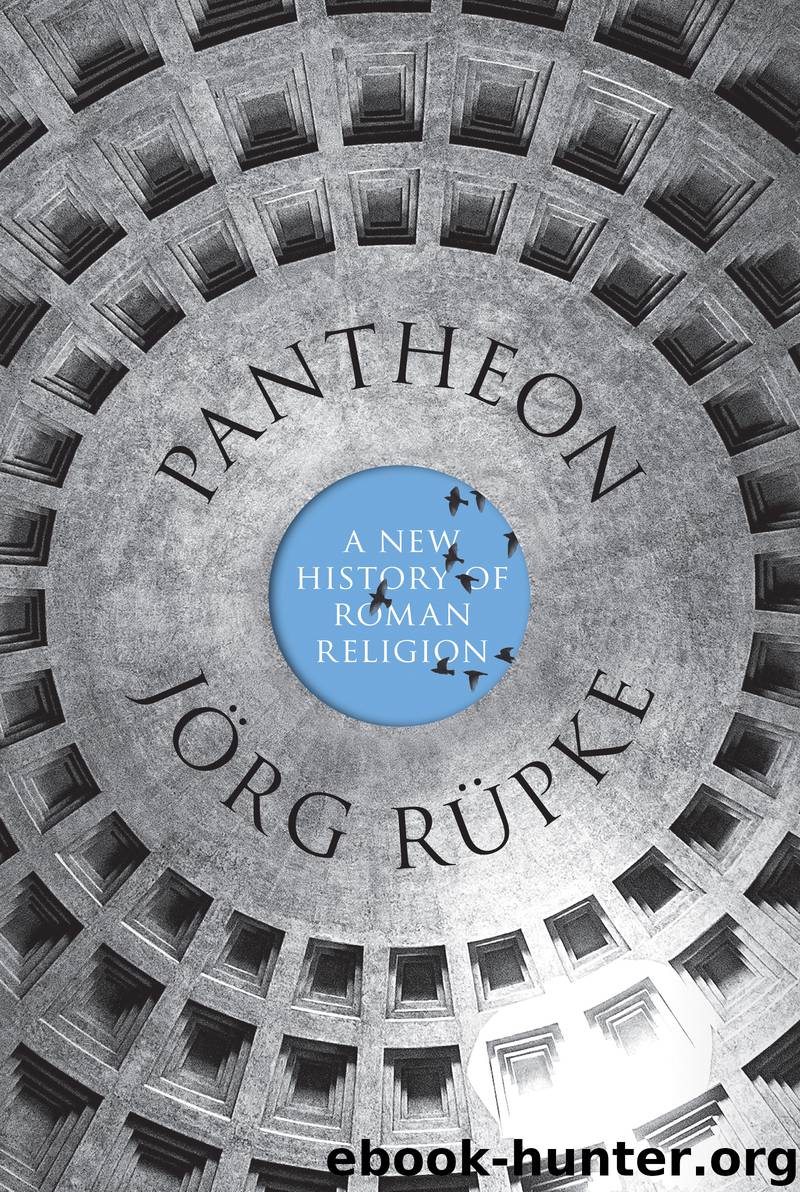Pantheon by Rüpke Jörg; Richardson David M. B.;

Author:Rüpke, Jörg; Richardson, David M. B.;
Language: eng
Format: epub
Publisher: Princeton University Press
59. Gilded silver patera from Parabiago, showing the triumph of Mater Magna/Cybele and Attis, fourth century AD. Milan, Castello Sforzesco, Civiche Raccolte d’Arte Applicata ed Incisioni. Photo Giovanni Dall’Orto, used by kind permission. akg-images / De Agostini Picture Lib. / G. Cigolini.
5. Founders of Religion
Religious authority could be won by others besides the visionaries who were held in such high regard. New forms of personal communication proposed by a person (or a group) could be attractive, even though the content offered might not be at all spectacular. Bearers of religious knowledge need not be prophets or deities, but might instead be organizers and founders of religions. Fronto, in his correspondence with Marcus Aurelius, describes the second king Numa as a founder, in terms that go beyond those used in earlier texts that attribute to him the role of institutionalizing religion. For Fronto, Numa is an “originator of ritual meals,” the “first to institute sacred banquets,” and a “promulgator of laws establishing feast days.”71 Lucian saw Peregrinus in similar terms, although as someone who exploited qualities instilled in Christians by the “first lawgiver” (nomothetês).72
Nomothetês in this sense of the word describes those founders of new temples who laid down detailed rules prescribing the way future users should configure religious communication within those establishments. Probably in the second or early third century, in Aquae Flaviae, today Panóias in northern Portugal, Gaius Calpurnius Rufinus established a cult with mystaria (sic), probably fed by his own experiences in his hometown of Perge. He prescribed in detail how and where animals were to be slaughtered and their blood dispersed, what was to be burned and what consumed.73 Guidelines already suggested to future visitors by the detailed physical features formed in the rock—they included pits, paths, and what may have been walls—were further specified by the founder in various texts that he inscribed in the rock itself.
What in Panóias remained a unique phenomenon, although it had a lasting effect there, led in other instances to ever new foundation events, spurring on ever new generations of founders. Many of these remained unknown, while others were subsequently regarded as philosophers, “Valentinians” perhaps, not as founders of cults.74
To look at a further instance, cult practices for the worship of Mithras were disseminated locally in southern Asia Minor, where they underwent changes in the Hellenistic Period. In the final quarter of the first century AD, they were transported out of that region by a person unknown to us, who gave these practices a form distinctly different from the one that persisted in the empire of the Parthians and then the Sassanids.75
This unknown individual brought to the fore the image of an action performed by the god’s own hand: the killing of a bull by means of a dagger (fig. 60); he thus satisfied the requirement construed as central to the cult’s tradition, the sacrifice of a bull. But at the same time he introduced a clearly countervailing circumstance, for the small size of the cult locale ruled out any reenactment of the sacrifice.
Download
This site does not store any files on its server. We only index and link to content provided by other sites. Please contact the content providers to delete copyright contents if any and email us, we'll remove relevant links or contents immediately.
| Africa | Americas |
| Arctic & Antarctica | Asia |
| Australia & Oceania | Europe |
| Middle East | Russia |
| United States | World |
| Ancient Civilizations | Military |
| Historical Study & Educational Resources |
The Daily Stoic by Holiday Ryan & Hanselman Stephen(3213)
The Fate of Rome: Climate, Disease, and the End of an Empire (The Princeton History of the Ancient World) by Kyle Harper(2988)
People of the Earth: An Introduction to World Prehistory by Dr. Brian Fagan & Nadia Durrani(2690)
Ancient Worlds by Michael Scott(2607)
Babylon's Ark by Lawrence Anthony(2563)
The Daily Stoic by Ryan Holiday & Stephen Hanselman(2442)
Foreign Devils on the Silk Road: The Search for the Lost Treasures of Central Asia by Peter Hopkirk(2422)
India's Ancient Past by R.S. Sharma(2406)
MOSES THE EGYPTIAN by Jan Assmann(2360)
The Complete Dead Sea Scrolls in English (7th Edition) (Penguin Classics) by Geza Vermes(2222)
Lost Technologies of Ancient Egypt by Christopher Dunn(2187)
The Earth Chronicles Handbook by Zecharia Sitchin(2166)
24 Hours in Ancient Rome by Philip Matyszak(2041)
Alexander the Great by Philip Freeman(2026)
Aztec by Gary Jennings(1965)
The Nine Waves of Creation by Carl Johan Calleman(1875)
Curse Tablets and Binding Spells from the Ancient World by Gager John G.;(1829)
Before Atlantis by Frank Joseph(1801)
Earthmare: The Lost Book of Wars by Cergat(1780)
